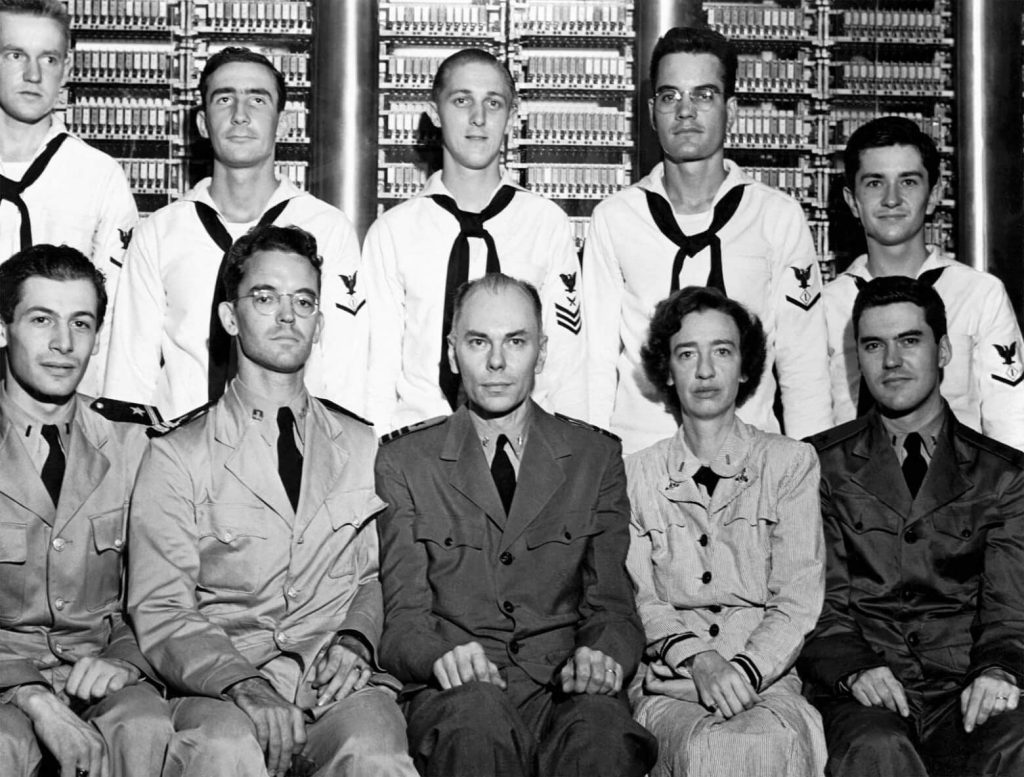

We talk about the life and achievements of Grace Hopper, an outstanding programmer who played a key role in transforming computers from inaccessible machines to user-friendly tools. From creating the first compiler to developing the COBOL programming language, Grace Hopper has left an indelible mark on the world of technology. Learn more about her contributions to the computer industry and her influence on modern programming.
Hopper played a particularly important role in making the computer field more open. Since 1994, a conference of women computer scientists named in her honor has been held. There is a Hopper Scholarship Fund to support girls and women participating in the program.
During an interview, TV host David Letterman asked Hopper how she knew about computers. The scientist replied that she did not know anything. Hopper, one of the pioneers, acted largely on inspiration and had absolutely no support from her leadership, both on the Enterprise and in the fleet. For example, the main goal of her life is to teach a computer to understand not only numerical commands, but also human language.
But she succeeded. Programming is anything that requires special skills and training, but Hopper’s idea made an important contribution to making the programmer’s job easier. And ordinary people do not need to learn the wisdom of binary code to use a computer.

She studied mathematics and physics and received a bachelor’s degree in these majors in 1928. Then she entered Yale University. So, in 1934, she defended her doctoral thesis on irreducible polynomials and the theory of rings. Hopper’s scientific supervisor was the famous Norwegian mathematician Oyster Ore.
After receiving her PhD in mathematics, Hopper returned to her alma mater, Vassar University, and began a career in education. But this career path did not last long – in 1939, the Second World War began, in which the United States became a participant 2 years after the attack on Pearl Harbor.
It was not immediately possible to contribute to the victory of Hopper’s allies. At 34, Hopper was too old to join the army. Also, the scientist lacked weight – she was distinguished by a thin physique.
At the same time, more and more men joined the army and quit their jobs. Areas such as mathematics were in dire need of qualified specialists, who fell into Hopper’s hands.
In 1943, thanks to the WAVES program (“a woman was accepted into the voluntary rescue service”), she was able to enter the reserve of the US Navy.
Initially, Hopper attended the Reserve Cadet School at Smith College in Massachusetts and graduated with the best results in the course.

After a year of training, Lt. Col. Hopper (the equivalent of our Lt. Col.) was sent to the Ordnance Computing Design Office at Harvard University to work on the Mark I, an automatic sequence control computer. In fact, it was the first programmable computer in America.
Service in the army did not bother her. On the contrary, she described the experience as “the most complete freedom I’ve ever had.” “In addition, in those years, the army and navy were the most promising places of work for many innovative scientists (Hello Oppenheimer!).
Hopper called the Mark I “a stunning monster” and the most beautiful device she had ever seen. The Mark I was 17 meters long and 2.5 meters high and occupied another room at Harvard University.
At that time, the term “computer programming” did not exist, but this can be called exactly the task that Grace was engaged in at that time. The team worked on complex calculations for the army, including calculating the missile’s flight path and creating a firing range table for the new anti-aircraft guns.
Hopper worked under the leadership of computer engineering pioneer Howard Aiken. In 1946, he commissioned Hopper to edit the Mark I’s Operation and Maintenance Manual.

Over the years, the Mark I has relied on improvised work methods by team members. Hopper faced a very ambitious task – to combine scattered knowledge about machines and create detailed professional instructions.
Due to the large volume of data, scientists have compared the project to the creation of a “computer Bible”. As a result, a book with a volume of 500 pages was released. Hopper designed in detail all aspects of the physical components of the Mark I, the complexity of operation and maintenance.
This manual included detailed instructions for programming the machine, making it the first computer programming textbook.
After successfully completing the task, Aiken appreciated Hopper’s merits and appointed her deputy. She then wrote several articles on the Mark I, built the computing machine for the Mark II and Mark III, with Hopper on his team.
At that time, Hopper unwittingly contributed to the appearance of the terms “bug” and “debugging” in computer life. In 1947, during testing of the Mark II, the machine failed due to the fact that a bug got into the computer case.
Translated from English, a bug is a mistake, or a bug is a shortcoming. Hopper inserted this insect into his technical diary, mentioning the Bug and writing: “the first case of the detection of a bug”. But this term entered history precisely as an error or failure in the operation of computer equipment.

In 1949, Hopper was offered the position of chief mathematician at the technological company Eckert-Mauchly Computer Corporation. Founders John Mockley and John Presper Eckert created the ENIAC computer for the US military in 1946.
Hopper was invited to work on the UNIVAC I, America’s first all-electronic digital computer for general use as well as for military use. In 1950, the company sold its assets to Remington Land, after which Hopper headed the automatic programming development department.
The UNIVAC I could handle more information than the Mark I and was very attractive to Hopper. The computer performed 455 multiplication operations per second and could store about 1,000 operations in memory on the Mercury delay line.
In addition, she had more freedom in the commercial sphere. Hopper took advantage of this and experimented with new ways of using computers for coding.
Scientists became interested in automatic programming. Later, she mentioned that during her work, she was too lazy to rewrite the program for setting up the equipment many times.
That is why the a-0 compiler appeared in 1952. It should be understood that the program at that time was a set of mathematical descriptions that had to be processed by several other programs. It was long and difficult.
The A-0 compiler made it possible to convert a high-level computer language into binary, that is, a machine programming language, with just 1 program. In parallel with Hopper, other developers were developing similar programs. For example, in the same 1952, the autocode compiler was launched at the University of Manchester under the leadership of Alec Gleny.
But the very term “compiler” was coined by Hopper and her team at Remington Rand. The functionality of the A-0 doesn’t quite match what the term means today. Rather, it can be called an application downloader and linker.
However, it was a significant and important milestone in the development of programming. Hopper laid the foundation for modern programming languages that facilitate communication between humans and computers and allow them to perform complex tasks with a minimum number of commands.
After A – 0, updated versions-a-1, a-2, etc. were released. the first customers received the a-2 compiler by the end of 1953. Remington Land provided them with the source code for the A-2 and suggested improvements for the UNIVAC.
Meanwhile, Hopper continued to develop the idea of writing programs with words rather than symbols. In her opinion, the programming language should be closer to everyday English, and not to binary code. This makes using the computer more understandable for the average user.
Computers were just beginning to spread among ordinary users, mainly in companies. The lack of engineering and mathematical education seemed to be an insurmountable obstacle to the use of computers.
Hopper saw the huge potential of using computers in business, for example for payroll, so she continued her research and attempts.

The management of Remington Land did not share Hopper’s vision. But she didn’t care. The scientists’ statements are divided into quotes, of which 1 says: “I have a clock on the wall that goes counter-clockwise because I’m trying to fight it.”
In 1956, her team launched FLOW-MATIC, the first programming language to use language commands. The innovation of this language was the syntax, in which data and operations with them were shared.
Only the operation was expressed verbally, and the data was entered through a pre-printed form. FLOW-MATIC became the basis of Kobol.
COBOL appeared at the Spring 1959 Conference on Data Processing System Languages. This was implemented by the organization CODASYL, whose main goal is to create a standardized programming language for business.
The basis of Kobol was FLOW-MATIC Hopper, and another source of influence was IBM COMTRAN.1 Kobol was created not only by Hopper, but also by the efforts of many people, but the fact that her brainchild was at the center of the language earned her the nickname “Grandma Kobol” ..
Hopper was engaged in the development of this language, both in the military and in civilian spheres. She also worked on a compiler for Kobol.

The language uses English keywords and its syntax is close to complete English sentences. Among the advantages is easy readability of programs.
Among the disadvantages is bulkiness. For example, what in similar languages is expressed as y = x;, in Cobol will look like this – MOVE x TO y.
KOBOL was also criticized for its lack of structure. The Dutch scientist and one of the developers of the concept of structured programming, Edsger Dijkstra, even said that using Cobol is “brain-crippling” and that teaching it is a “criminal offense”.
For all its shortcomings, COBOL became widely used in the 1960s and 1970s. More and more computers flashed in every corporate office, just as Hopper wanted.
By the 1980s, KOBOL was considered obsolete, but, as before, it remained popular. As of 1997, Kobold code handled 90% of the world’s financial transactions and 75% of commercial transactions.
COBOL is still used, especially in the US, mainly to support existing applications. As of August 2023, it even ranked 15th most popular among all programming languages.
The popularity of the language has many reasons. Decades of use have made KOBOL reliable and stable. With its help, you can process large volumes of data and at the same time do not need expensive equipment. COBOL is compatible with other languages and technologies such as Java, C#, SQL, XML, etc.
During her career in the computer industry, Hopper remained in the Naval Reserve. In 1966, when the scientist turned 60 years old, the US Navy offered her a lifetime contract. So Hopper tried to improve the computer program of the fleet.
Scientists put forward the idea of replacing large centralized computer systems with a network of many small computers. Thus, all users will be able to access the shared database, regardless of their location on the network.
This innovation ultimately led to the creation of the Internet, originally developed for military purposes, in the military domain.

In addition, Hopper worked on the development of standards for testing computer systems.
Her dedication to the cause earned the admiration of Hopper’s subordinates, who called her “amazing grace.” And in 1985, she was awarded the rank of rear admiral. At that time, Hopper was 79 years old.

Hopper continued to work after her final retirement in 1986. She gives public lectures and provides consulting services to IT companies.
Grace Hopper died in 1992. At that time, computers were no longer uncommon, at least in the United States. And, as scientists dreamed, they understood English and other human languages.
Hopper was known for her unique character. She was skeptical of military training and believed that it was better to apologize later than to wait for permission. In Hopper’s office there was a Pirate Flag, adding to the irony of the fact that she served in the Navy.
In 1986, Hopper was awarded the “Medal for Meritorious Service.” And after her death, the missile frigate Uss Hopper, the supercomputer Clay XE6 Hopper and Yale University were named in honor of Hopper.

Hopper played a particularly important role in making the computer field more open. Since 1994, a conference of women computer scientists named in her honor has been held. There is a Hopper Scholarship Fund to support girls and women participating in the program.
During an interview, TV host David Letterman asked Hopper how she knew about computers. The scientist replied that she did not know anything. Hopper, one of the pioneers, acted largely on inspiration and had absolutely no support from her leadership, both on the Enterprise and in the fleet. For example, the main goal of her life is to teach a computer to understand not only numerical commands, but also human language.
But she succeeded. Programming is anything that requires special skills and training, but Hopper’s idea made an important contribution to making the programmer’s job easier. And ordinary people do not need to learn the wisdom of binary code to use a computer.
